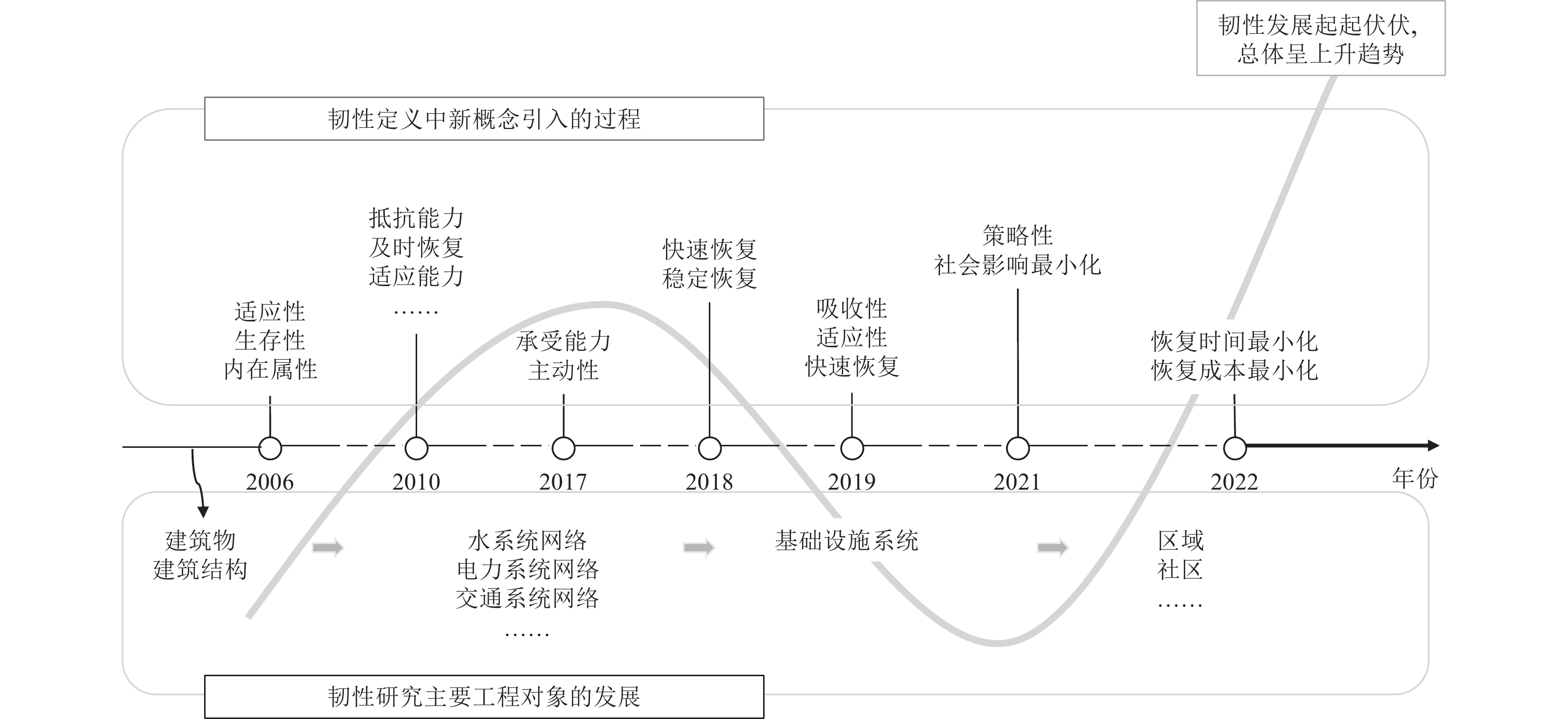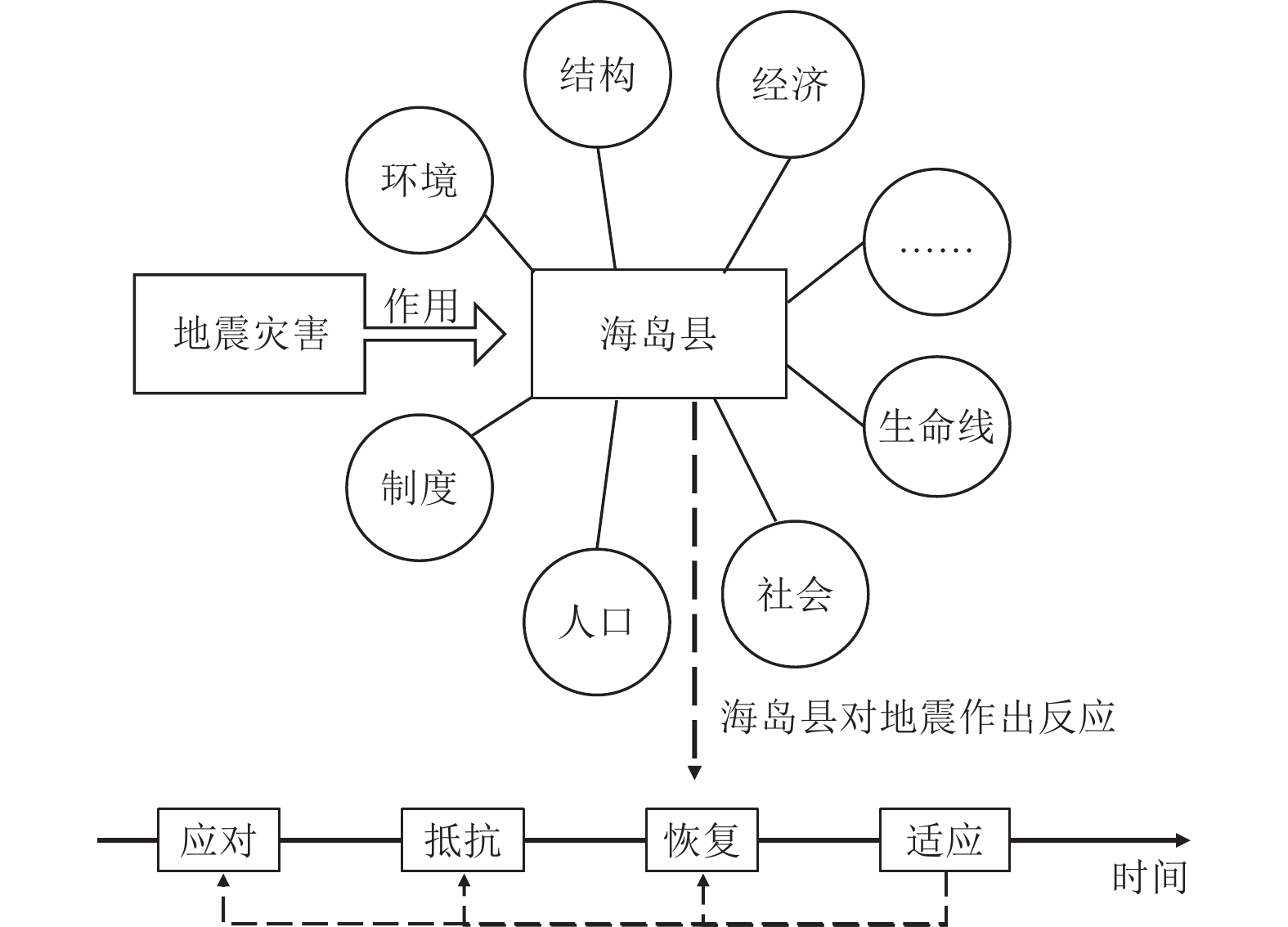Research on the Evaluation Indicator System of Seismic Resilience in Island Counties of China
-
摘要: 本文以中国海岛县地震韧性为主题展开研究工作,首先系统梳理地震韧性理论的发展,介绍地震韧性概念的具体内涵,包括鲁棒性、冗余性、智慧性、可恢复性4个方面,涉及技术、组织、社会、经济、环境5个维度。结合中国海岛地震灾害的特征,将地震情景下的海岛县行为概括为应对、抵抗、恢复、适应4个阶段,继而归纳得出海岛县对地震灾害的应对能力、抵抗能力、恢复能力和适应能力为海岛县地震韧性的具体构成,并基于此提出一个包含4个一级指标、8个二级指标和34个三级指标的中国海岛县地震韧性评价指标体系,命名为SREICC-EIS,同时对其各项指标数据来源和指标体系适用性进行讨论。该体系结合多准则决策方法可进一步形成地震韧性综合评价模型,从而实现中国海岛县地震韧性的量化评价,支持我国海岛县防震减灾事业发展。Abstract: This study examines the seismic resilience of China’s island counties. It begins with a comprehensive review of the development of seismic resilience theory, which encompasses four key components: robustness, redundancy, resourcefulness, and recovery. These elements span five dimensions: technology, organization, society, economy, and environment. In the context of the seismic hazards faced by China's island counties, the response of these counties to earthquakes is categorized into four stages: preparation, resistance, recovery, and adaptation. Based on these stages, the study defines the seismic resilience of island counties as a combination of their ability to prepare for, resist, recover from, and adapt to seismic hazards. Building on this framework, an Evaluation Indicator System for Seismic Resilience of Island Counties in China (SREICC-EIS) is proposed. This system includes 4 primary indicators, 8 secondary indicators, and 34 tertiary indicators, along with data sources for each index and the applicability of the system. The SREICC-EIS can be used to develop an evaluation model in conjunction with Multi-Criteria Decision-Making (MCDM) methods, enabling quantitative assessment of seismic resilience in China’s island counties and providing support for disaster prevention and mitigation efforts.
-
表 1 韧性定义发展
Table 1. The development of resilience definition
研究对象 定义 时间 来源 社会 系统减轻灾害、在灾害发生时控制灾害影响,并以最大限度地减少社会混乱和减轻未来地震影响的方式开展恢复活动的能力。 2003年 (Bruneau等,2003) 工程系统 系统在不利影响下通过改变其非本质属性并重建自身来适应和生存的能力。 2006年 (Manyena,2006) 工程系统 系统在特定时间内(通常是系统的生命周期等)抵抗、恢复和适应灾害冲击的能力,将其量化为系统功能随着时间的变化。 2010年 (Cimellaro等,2010) 工程系统 系统在灾害准备阶段抵御和吸收外部干扰的吸收能力、应急响应阶段的适应能力、灾后恢复阶段快速恢复到可接受水平的能力。 2019年 (Nocera等,2019) 社区 社区通过遵循一些预先确定的活动来减轻地震灾害社会影响的能力,使系统准备好应对即将来临的地震灾害并使其造成的损失最小化的能力。 2019年 (Atrachali等,2019) 城市 城市系统积极应对地震并从地震中恢复的能力,是一个动态过程。 2020年 (Fontana等,2020) 结构 结构在地震期间维持某些功能的能力,以及其在震后恢复到所需的目标功能的能力。 2020年 (González等,2020) 医院 系统在地震灾害期间或灾后立即恢复其功能的能力。 2020年 (Shang等,2020) 基础设施 系统吸收扰动的影响,并在最短时间内以最小成本(财政、人力、工作量等)恢复其功能所有方面的某种能力,可以被看作是在中断后如何保持功能以及如何快速获得功能的能力。 2023年 (Kamissoko等,2023) 表 2 指标体系建立的参考资料
Table 2. References for SREICC-EIS
材料分类 名称来源 法律法规 《中华人民共和国防震减灾法》
《中华人民共和国城乡规划法》
《中华人民共和国突发事件应对法》标准规范 GB 50011—2010《建筑抗震设计规范》
GB 50223—2008《建筑工程抗震设防分类标准》
GB 50413—2007《城市抗震防灾规划标准》
GB 50180—2018《城市居住区规划设计标准》
GB 51143—2015《防灾避难场所设计规范》(2021年版)
GB/T 23648-2009《社区志愿者地震应急与救援工作指南》文献资料 《县城防震韧性评价指标体系研究》(杨春晨,2019)
《基于地震灾害的城市安全韧性评估》(谢菊香,2020)
《城市社区抗震韧性评估模型优化研究》(景梦晗,2021)
《海岛地震灾害特征分析及危险性评价研究》(崔涵,2020)
《中国县域海岛地震灾害社会脆弱性研究》(王春晓,2021)
《Resilience assessment of regional areas against earthquakes using multi-source information fusion》(Chen等,2021)
《Dynamic modeling of in-event interdependencies in community resilience》(Sediek等,2020)
《Integrating household decisions in quantifying the seismic resilience of
communities subjected to a sequence of earthquakes》(Sediek等,2022)
《Toward quantification of seismic resilience in Iran: Developing an integrated indicator system》(Atrachali等,2019)表 3 中国海岛县地震韧性评价指标体系
Table 3. Evaluation indicator system of s eismic resilience for island counties of China
-
陈宣先,王培茗,2018. 韧性城市研究进展. 世界地震工程,34(3):78−84.Chen X. X., Wang P. M., 2018. Research progress on resilient cities. World Earthquake Engineering, 34(3): 78−84. (in Chinese) 崔涵,2020. 海岛地震灾害特征分析及危险性评价研究. 青岛:中国海洋大学.Cui H., 2020. Study on characteristics analysis of island seismic disaster and seismic hazard assessment. Qingdao:Ocean University of China. (in Chinese) 窦圣宇,2021. 海岛地震应急能力评价及演化特征研究. 青岛:中国海洋大学.Dou S. Y., 2021. Research on the evaluation and evolution characteristics of earthquake emergency response capacity of islands. Qingdao:Ocean University of China. (in Chinese) 焦柳丹,邓佳丽,吴雅等,2022. 基于PSR+云模型的城市韧性水平评价研究. 生态经济,38(5):114−120.Jiao L. D., Deng J. L., Wu Y., et al., 2022. Evaluation of urban resilience based on PSR+cloud model. Ecological Economy, 38(5): 114−120. (in Chinese) 景梦晗,2021. 城市社区抗震韧性评估模型优化研究. 成都:西南交通大学.Jing M. H., 2021. Study on optimization of seismic resilience evaluation model for urban communities. Chengdu:Southwest Jiaotong University. (in Chinese) 李康晨,2018. 城市韧性评价指标体系构建及应用研究. 广州:暨南大学.Li K. C., 2018. Research on the design and application of evaluation indicator system of city resilience. Guangzhou:Jinan University. (in Chinese) 刘玉国,李欢,郑涵等,2022. 中国活动构造与地震及地质灾害的关系研究进展及展望. 自然灾害学报,31(1):1−14.Liu Y. G., Li H., Zheng H., et al., 2022. Research progress and prospect of the relationship among active tectonics, earthquakes and geological disasters in China. Journal of Natural Disasters, 31(1): 1−14. (in Chinese) 师钰,2020. 城市群区域韧性评价及优化策略研究. 焦作:河南理工大学.Shi Y., 2020. Study on the evaluation and optimization strategy of regional resilience of urban agglomerations. Jiaozuo:Henan Polytechnic University. (in Chinese) 时哲明,2021. 基于韧性城市理念的城市综合防灾规划研究−−以新郑市中心城区为例. 绵阳:西南科技大学.Shi Z. M., 2021. Study on comprehensive disaster prevention planning based on resilient city concept,taking Xinzheng city center as an example. Mianyang:Southwest University of Science and Technology. (in Chinese) 王春晓,2021. 中国县域海岛地震灾害社会脆弱性研究. 青岛:中国海洋大学.Wang C. X., 2021. Research on social vulnerability of seismic disaster in county islands of China. Qingdao:Ocean University of China. (in Chinese) 王图亚,2019. 既有居住区抗震韧性评价与提升策略研究. 北京:中国建筑科学研究院.Wang T. Y., 2019. Research on evaluation and improvement strategy of seismic resilience of residential areas. Beijing:China Academy of Building Research. (in Chinese) 王燕语,范圣权,范乐,2021. 基于多因素、多层次评判的多灾种下城市安全韧性评价指标研究. 建筑科学,37(1):82−88.Wang Y. Y., Fan S. Q., Fan L., 2021. Research on assessment index of urban safety resilience under multi-hazards based on multi-factors and multi-level evaluation. Building Science, 37(1): 82−88. (in Chinese) 谢菊香,2020. 基于地震灾害的城市安全韧性评估. 重庆:重庆大学.Xie J. X., 2020. Urban resilience assessment based on earthquake disaster. Chongqing:Chongqing University. (in Chinese) 杨春晨,2019. 县城防震韧性评价指标体系研究−−以定远县县城为例. 合肥:安徽建筑大学.Yang C. C., 2019. Study on evaluation index system of earthquake resistance toughness of county town − taking Dingyuan county as an example. Hefei:Anhui Jianzhu University. (in Chinese) 殷凯,2021. 黑龙江省城市韧性时空演变及其影响因素研究. 哈尔滨:哈尔滨师范大学.Yin K., 2021. Research on the spatio-temporal evolution and influencing factors of urban resilience in Heilongjiang province. Harbin:Harbin Normal University. (in Chinese) 臧鑫宇,王逸轩,王峤,2021. 应对典型灾害的城市适灾韧性评价与韧性地图划定. 建筑学报,(S1):146−150.Zang X. Y., Wang Y. X., Wang Q., 2021. Urban resilience evaluation and resilience map zoning coping with the typical disasters. Architectural Journal, (S1): 146−150. (in Chinese) 周倩倩,2020. 城市生命线工程防灾韧性度评价. 秦皇岛:华北理工大学.Zhou Q. Q., 2020. Evaluation of disaster prevention toughness of urban lifeline project. Qinhuangdao:North China University of Science and Technology. (in Chinese) Atrachali M., Ghafory-Ashtiany M., Amini-Hosseini K., et al., 2019. Toward quantification of seismic resilience in Iran: Developing an integrated indicator system. International Journal of Disaster Risk Reduction, 39: 101231. doi: 10.1016/j.ijdrr.2019.101231 Bruneau M., Chang S. E., Eguchi R. T., et al., 2003. A framework to quantitatively assess and enhance the seismic resilience of communities. Earthquake Spectra, 19(4): 733−752. doi: 10.1193/1.1623497 Chen W. Y., Zhang L. M., 2021. Resilience assessment of regional areas against earthquakes using multi-source information fusion. Reliability Engineering & System Safety, 215: 107833. Cimellaro G. P., Reinhorn A. M., Bruneau M., 2010. Framework for analytical quantification of disaster resilience. Engineering Structures, 32(11): 3639−3649. doi: 10.1016/j.engstruct.2010.08.008 Cimellaro G. P., Arcidiacono V., Reinhorn A. M., 2021. Disaster resilience assessment of building and transportation system. Journal of Earthquake Engineering, 25(4): 703−729. doi: 10.1080/13632469.2018.1531090 Dikmen S. Ü., Akbiyikli R., Sönmez M., 2020. Assessment of the disaster recovery progress through mathematical modelling. Teknik Dergi, 31(4): 10113−10126. doi: 10.18400/tekderg.473099 Fontana C. , Cianci E. , Moscatelli M. , 2020. Assessing seismic resilience of school educational sector. An attempt to establish the initial conditions in Calabria Region, southern Italy. International Journal of Disaster Risk Reduction, 51 : 101936. González C., Niño M., Jaimes M. A., 2020. Event-based assessment of seismic resilience in Mexican school buildings. Bulletin of Earthquake Engineering, 18(14): 6313−6336. doi: 10.1007/s10518-020-00938-5 Holling C. S., 1973. Resilience and stability of ecological systems. Annual Review of Ecology and Systematics, 4(1): 1−23. doi: 10.1146/annurev.es.04.110173.000245 Kalfarisi R., Hmosze M., Wu Z. Y., 2022. Detecting and geolocating city-scale soft-story buildings by deep machine learning for urban seismic resilience. Natural Hazards Review, 23(1): 04021062. doi: 10.1061/(ASCE)NH.1527-6996.0000541 Kamissoko D., Nastov B., Allon M., 2023. Improved model for continuous, real-time assessment and monitoring of the resilience of systems based on multiple data sources and stakeholders. Structure and Infrastructure Engineering, 19(8): 1122−1137. doi: 10.1080/15732479.2021.2009883 Kong J. J., Simonovic S. P., Zhang C., 2019. Resilience assessment of interdependent infrastructure systems: a case study based on different response strategies. Sustainability, 11(23): 6552. doi: 10.3390/su11236552 Manyena S. B., 2006. The concept of resilience revisited. Disasters, 30(4): 434−450. doi: 10.1111/j.0361-3666.2006.00331.x Narjabadifam P., Hoseinpour R., Noori M., et al., 2021. Practical seismic resilience evaluation and crisis management planning through GIS-based vulnerability assessment of buildings. Earthquake Engineering and Engineering Vibration, 20(1): 25−37. doi: 10.1007/s11803-021-2003-1 Nocera F. , Gardoni P. , Cimellaro G. P. , 2019. Time-dependent probability of exceeding a target level of recovery. ASCE-ASME Journal of Risk and Uncertainty in Engineering Systems, Part A: Civil Engineering, 5 (4): 04019013. Sardari F., Dehkordi M. R., Eghbali M., et al., 2020. Practical seismic retrofit strategy based on reliability and resiliency analysis for typical existing steel school buildings in Iran. International Journal of Disaster Risk Reduction, 51: 101890. doi: 10.1016/j.ijdrr.2020.101890 Sediek O. A., El-Tawil S., Mccormick J., 2020. Dynamic modeling of in-event interdependencies in community resilience. Natural Hazards Review, 21(4): 04020041. doi: 10.1061/(ASCE)NH.1527-6996.0000413 Sediek O. A., El-Tawil S., Mccormick J., 2022. Integrating household decisions in quantifying the seismic resilience of communities subjected to a sequence of earthquakes. Natural Hazards Review, 23(2): 04022003. doi: 10.1061/(ASCE)NH.1527-6996.0000552 Shang Q. X., Wang T., Li J. C., 2020. Seismic resilience assessment of emergency departments based on the state tree method. Structural Safety, 85: 101944. doi: 10.1016/j.strusafe.2020.101944 Takewaki I., Fujita K., Yamamoto K., et al., 2011. Smart passive damper control for greater building earthquake resilience in sustainable cities. Sustainable Cities and Society, 1(1): 3−15. doi: 10.1016/j.scs.2010.08.002 Toroghi S. S. H., Thomas V. M., 2020. A framework for the resilience analysis of electric infrastructure systems including temporary generation systems. Reliability Engineering & System Safety, 202: 107013. Vona M., Mastroberti M., Mitidieri L., et al., 2018. New resilience model of communities based on numerical evaluation and observed post seismic reconstruction process. International Journal of Disaster Risk Reduction, 28: 602−609. doi: 10.1016/j.ijdrr.2018.01.010 Wen W. P., Zhang M. H., Zhai C. H., et al., 2019. Resilience loss factor for evaluation and design considering the effects of aftershocks. Soil Dynamics and Earthquake Engineering, 116: 43−49. doi: 10.1016/j.soildyn.2018.10.007 Zhang C., Kong J. J., Simonovic S. P., 2018. Restoration resource allocation model for enhancing resilience of interdependent infrastructure systems. Safety Science, 102: 169−177. doi: 10.1016/j.ssci.2017.10.014 Zhou W. M., Kalonji G., Chen C., et al., 2022. A three-staged framework for measuring water supply resilience in rural China based on PLS-SEM. Scientific Reports, 12(1): 4323. doi: 10.1038/s41598-022-08112-4 -




 下载:
下载:


